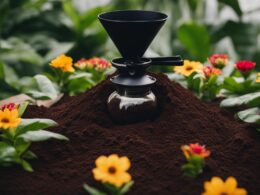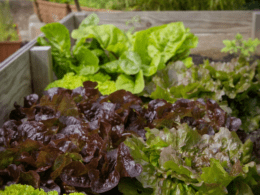Do you enjoy adding vibrant color and cheerful blooms to your garden? Potted marigolds are a fantastic choice for bringing a touch of sunshine to your outdoor space. But how long can you expect these beautiful flowers to last?
Understanding the lifespan of potted marigolds is essential for keeping your garden looking its best. With proper care and maintenance, these hardy plants can provide you with weeks, and sometimes even months, of stunning blooms. By choosing the right variety, extending the blooming period, and overwintering your potted marigolds, you can ensure their longevity. However, it’s important to be aware of signs of decline and when it’s time for replacement.
In this article, we’ll explore how to care for your potted marigolds to maximize their lifespan, as well as tips for recycling and replanting them. Let’s dive in and discover the secrets to keeping your potted marigolds thriving for as long as possible.
Quick Summary
- Understanding the growth stages of potted marigolds is important for their longevity
- Water potted marigolds deeply once or twice a week, avoid over-saturation
- Regularly inspect for pests or diseases and take immediate action
- Proper care and following the mentioned steps will ensure the health and longevity of marigolds
Understanding the Lifespan of Potted Marigolds
Do you ever wonder how long potted marigolds can brighten up your space? Understanding marigold care is essential if you want your potted marigolds to thrive and last as long as possible. These vibrant flowers go through different growth stages, and by knowing what to expect, you can ensure their longevity.
When you first bring home your potted marigolds, they’re typically in the seedling stage. They’re delicate and require extra care. Make sure to provide them with enough sunlight, water, and well-draining soil. As they mature, you’ll notice the leaves becoming fuller and the stems growing stronger.
Once your marigolds reach the vegetative stage, they’ll start producing more leaves and branches. This is the time to fertilize them regularly to encourage healthy growth. Pay attention to any signs of pests or diseases and take immediate action to prevent damage.
The flowering stage is the most exciting and rewarding stage for potted marigolds. The flowers will start to bloom, adding a burst of color to your space. Deadheading, or removing spent flowers, will help prolong the blooming period.
With proper care and attention, potted marigolds can last for several months, providing you with beautiful blooms and enhancing the ambiance of your surroundings. Remember to water them regularly, keep an eye out for pests or diseases, and enjoy the vibrant display they offer.
Proper Care and Maintenance for Potted Marigolds
To ensure the enduring beauty of your potted marigolds, it’s important to properly care for and maintain them.
One key aspect of caring for potted marigolds is watering. These vibrant flowers thrive when their soil is kept consistently moist, but not overly saturated. Aim to water them deeply once or twice a week, allowing the top inch of soil to dry out between waterings. This ensures that the roots receive enough moisture without being waterlogged, which can lead to rot.
When it comes to fertilizing potted marigolds, it’s best to use a balanced, water-soluble fertilizer every two to three weeks during the growing season. This provides the necessary nutrients for healthy growth and abundant blooms. Be sure to follow the instructions on the fertilizer package, as over-fertilizing can harm the plants.
In addition to watering and fertilizing, it’s important to regularly inspect your potted marigolds for any signs of pests or diseases. If you notice any issues, take immediate action to prevent further damage. Remove any damaged or dead foliage and treat the plants with an appropriate insecticide or fungicide, if necessary.
By following these tips and giving your potted marigolds the care they need, you can enjoy their vibrant beauty for a long time to come. Happy gardening!
Choosing the Right Variety of Marigolds
Make sure you choose the right variety of marigolds to add a vibrant and diverse range of colors and textures to your garden. When selecting marigolds for your pots, consider choosing different colors to create a visually stunning display.
There are various marigold varieties available, including the French marigold and the African marigold. French marigolds come in bright shades of yellow, orange, and red, while African marigolds offer larger blooms in yellows and oranges.
Before making your selection, it’s important to consider the growth requirements of marigolds. Marigolds thrive in full sun, so choose a variety that can tolerate direct sunlight for at least six hours a day. Additionally, marigolds prefer well-drained soil, so look for a variety that can thrive in your specific soil type. Some marigold varieties are more compact and are better suited for container gardening, while others can grow taller and may require staking for support.
By choosing the right variety of marigolds, you can ensure that your potted plants will not only last but also thrive. So, take the time to select different colors and consider the growth requirements of the marigolds to create a beautiful and successful potted garden.
Extending the Blooming Period of Potted Marigolds
To extend the blooming period of your potted marigolds, you can try deadheading and pinching back the spent flowers regularly. This will encourage the plant to produce new blooms and prevent it from wasting energy on producing seeds.
Additionally, it’s important to protect your marigolds from extreme temperatures by moving them indoors during cold snaps or providing shade during heatwaves.
Lastly, keep an eye out for pests like aphids or slugs, and take necessary steps to protect your plants from these invaders to ensure a longer blooming period.
Deadheading and Pinching Back
Trimming off the faded flowers on your potted marigolds will keep them looking vibrant and encourage new blooms. Deadheading, as this process is called, has many benefits for your plants. Not only does it improve the overall appearance of your marigolds, but it also helps to prevent diseases and pests from taking hold.
When deadheading, make sure to remove the entire faded flower, including the stem, to promote new growth. Additionally, pinching back your marigolds can help to create a bushier plant with more blooms. Simply use your fingers to pinch off the top growth, just above a set of leaves. This will encourage the plant to branch out and produce more flowers.
By practicing these pruning techniques, you can extend the blooming period of your potted marigolds and enjoy their vibrant colors for longer.
Protecting from Extreme Temperatures and Pests
Protecting from extreme temperatures and pests is crucial in order to ensure the health and longevity of your vibrant marigolds. To protect your potted marigolds from frost, it is important to bring them indoors or cover them with a frost blanket when the temperature drops below freezing. This will prevent the delicate flowers from wilting and dying. Additionally, it is important to take preventive measures to avoid common diseases that can affect marigolds. Avoid overwatering, as this can lead to root rot and other fungal diseases. You can also use organic insecticides to keep pests like aphids and whiteflies at bay. It is essential to regularly inspect your marigolds for any signs of pests or diseases and take immediate action to prevent them from spreading. By following these tips, you can protect your potted marigolds and enjoy their vibrant beauty for a longer period of time.
| Temperature Protection | Disease Prevention | |||
|---|---|---|---|---|
| Bring indoors | Avoid overwatering | |||
| Use frost blanket | Use organic insecticides | |||
| Regularly inspect for pests and diseases | Implement proper pruning techniques | to maintain healthy growth and reduce the risk of disease | ||
| Provide adequate sunlight and proper air circulation | to promote strong and resilient plants | |||
| Maintain a consistent watering schedule | to prevent both under and overwatering | |||
| Apply mulch around the base of the plants | to regulate soil temperature and retain moisture | |||
| Use companion planting techniques | to deter pests and attract beneficial insects | |||
| Remove any diseased or infected plant material promptly | to prevent the spread of diseases | |||
| Provide regular fertilization | to ensure optimal nutrient levels for plant health | |||
| Practice crop rotation | to prevent the buildup of pests and diseases in the soil | |||
| Monitor and adjust soil pH levels | to create a favorable environment for plant growth | |||
| Maintain proper spacing between plants | to prevent overcrowding and improve air circulation |
What is the Lifespan of Potted Hyacinths Compared to Potted Marigolds?
The potted hyacinths lifespan can vary depending on various factors such as care, environment, and genetics. On average, potted hyacinths live for around 2 to 3 weeks after blooming. In comparison, potted marigolds tend to have a longer lifespan, usually lasting for several months. It’s important to consider these differences when deciding which plant suits your preference and maintenance capabilities.
Overwintering Potted Marigolds
When overwintering potted marigolds, you can extend their lifespan by providing them with a suitable indoor environment and ensuring they receive adequate light and water.
Overwintering refers to the process of protecting plants from extreme winter conditions. To start, choose a location indoors that offers enough sunlight, such as a south-facing window. Make sure the temperature remains above freezing, around 55 to 60 degrees Fahrenheit, to prevent frost damage. Avoid placing the marigolds near drafts or heat sources, as sudden temperature changes can harm them.
Remember to water the plants regularly, but be careful not to overwater, as this can lead to root rot. Allow the soil to dry slightly between waterings, and use a well-draining potting mix. Additionally, keep an eye out for pests that may invade your indoor garden.
Common mistakes when overwintering marigolds include leaving them outside during freezing temperatures or neglecting their watering needs. By following these tips, you can help your potted marigolds survive the winter and flourish again in the spring.
Signs of Decline and Replacement
If your potted marigolds start showing signs of decline, it may be time to consider replacing them. It’s important to be aware of the decline indicators so you can take action before it’s too late. One of the most obvious signs is wilting or yellowing leaves, which can indicate a lack of water or nutrient deficiency. Another indicator is stunted growth or a lack of new blooms. If your marigolds are not thriving as they once were, it’s time to take action.
To rejuvenate your potted marigolds, there are several methods you can try. First, check the soil moisture and make sure you are providing enough water. Overwatering can also be detrimental to the health of your plants, so finding the right balance is key. Additionally, consider adding a slow-release fertilizer to provide the necessary nutrients. Pruning can also help remove any dead or diseased parts of the plant and promote new growth. If all else fails, it may be necessary to replace the marigolds with fresh ones.
To summarize, keeping an eye out for decline indicators and using rejuvenating methods can help prolong the lifespan of your potted marigolds. By taking action at the first signs of decline, you can ensure the safety and longevity of your plants.
| Decline Indicators | Rejuvenating Methods | |||
|---|---|---|---|---|
| Wilting or yellowing leaves | Check soil moisture and provide adequate water | |||
| Stunted growth or lack of blooms | Add slow-release fertilizer | |||
| Dead or diseased parts of the plant | Prune and remove | |||
| No improvement after trying other methods | Replace with fresh marigolds | No improvement after trying other methods | Replace with fresh marigolds and monitor for any signs of pests or diseases. |
Recycling and Replanting Potted Marigolds
Let’s talk about how we can recycle and replant our potted marigolds to give them new life! When it comes to recycling marigold pots, it’s important to prioritize safety. Before repotting marigolds, make sure to clean the pots thoroughly to remove any dirt or debris. This will help prevent the spread of diseases or pests that can harm your plants.
You can use a mixture of water and mild soap to clean the pots, or you can also use a diluted bleach solution for disinfection. After cleaning, rinse the pots well to remove any residue.
Once the pots are clean, it’s time to repot your marigolds. Choose a new pot that is slightly larger than the old one to allow for growth. Fill the new pot with fresh potting soil, making sure to leave enough space for the marigold’s root ball.
Carefully remove the marigold from its old pot, being gentle to avoid damaging the roots. Place the marigold in the new pot, making sure it is centered and at the same depth as before. Fill the remaining space with soil, gently pressing it down to secure the plant.
By recycling and replanting your potted marigolds, you can give them a fresh start and enjoy their vibrant blooms for a longer time. Remember, taking proper care and following these steps will help ensure the health and longevity of your marigolds. Happy gardening!
Frequently Asked Questions
Can potted marigolds be grown indoors?
Yes, potted marigolds can be grown indoors. Indoor marigold care is easy and they bring many benefits. They add beauty to your space, purify the air, and can even repel insects naturally.
How often should potted marigolds be watered?
To care for potted marigolds, water them regularly, but not too much. A good rule of thumb is to water when the top inch of soil feels dry. This will help keep your marigolds healthy and prevent overwatering.
What is the best fertilizer to use for potted marigolds?
The best organic fertilizers for potted marigolds are compost, well-rotted manure, and fish emulsion. You can also make a homemade fertilizer using banana peels and eggshells. These options are safe and effective for your plants.
Are potted marigolds prone to any specific pests or diseases?
Potted marigolds can be susceptible to aphids, spider mites, and powdery mildew. To prevent these pests and diseases, you can use natural remedies like neem oil, insecticidal soap, or a mixture of water and baking soda. Keep your marigolds healthy and vibrant!
Can potted marigolds be grown in hanging baskets?
Yes, potted marigolds can be grown in hanging baskets. They are easy to care for and bring several benefits when grown indoors, such as adding beauty to your space and repelling pests.
Conclusion
In conclusion, taking proper care of your potted marigolds can help extend their lifespan and keep them blooming for a longer period of time. Choose the right variety for your specific needs and consider overwintering them if you live in a colder climate. Keep an eye out for signs of decline and replace them when necessary.
And don’t forget, you can always recycle and replant your potted marigolds to continue enjoying their vibrant beauty year after year. Happy gardening!









